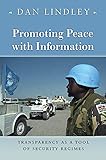Promoting Peace with Information : Transparency as a Tool of Security Regimes / Dan Lindley.
Material type: TextPublisher: Princeton, NJ : Princeton University Press, [2022]Copyright date: ©2007Description: 1 online resource (296 p.) : 15 tablesContent type:
TextPublisher: Princeton, NJ : Princeton University Press, [2022]Copyright date: ©2007Description: 1 online resource (296 p.) : 15 tablesContent type: - 9780691224251
- International agencies
- Peace-building
- Transparency in government
- POLITICAL SCIENCE / International Relations / General
- Agreed Framework
- Angola
- Asia Watch
- Buddhist party
- Canada
- Carney, Timothy
- Chayes, Abram
- Clandestine Radio
- Crocker, Chester
- Diesing, Paul
- Eckhard, Fred
- Evangelista, Matthew
- Findlay, Trevor
- Fort Necessity
- Germany
- Grey Wolves
- Grimstead, Patricia Kennedy
- Haggard, Stephan
- Hun Sen
- Indonesia
- Iraq War
- Isaac, Tasos
- Jervis, Robert
- Kennedy, Kevin
- Khmer Rouge
- Koenig, John
- League of Nations
- Ledgerwood, Judy
- Lipson, Charles
- Luanda Agreement
- Marquardt, James
- Milosevic, Slobodan
- Naples
- October War
- Open Society Institute
- Panayi, Stelios
- Portugal
- Quadruple Alliance
- Saxony
- Second Treaty of Paris
- ambient transparency
- balance of threat theory
- beneficent coercion
- bluffing
- coercion, beneficent
- ethnic conflict
- human rights
- hypotheses
- intelligence transparency
- optimistic miscalculation
- rogues
- secrecy
- self-transparency
- 352.8/8 22
- JC598
- JC598 .L56 2007eb
- online - DeGruyter
| Item type | Current library | Call number | URL | Status | Notes | Barcode | |
|---|---|---|---|---|---|---|---|
 eBook
eBook
|
Biblioteca "Angelicum" Pont. Univ. S.Tommaso d'Aquino Nuvola online | online - DeGruyter (Browse shelf(Opens below)) | Online access | Not for loan (Accesso limitato) | Accesso per gli utenti autorizzati / Access for authorized users | (dgr)9780691224251 |
Frontmatter -- Contents -- Preface and Acknowledgments -- 1. Promoting Peace with Information -- 2. Theory, Methods, and Case Selection -- 3. The Concert of Europe: Forum Diplomacy and Crisis Management -- 4. The United Nations Force in Cyprus -- 5. The United Nations Disengagement Observer Force in the Golan Heights -- 6. The United Nations Transition Assistance Group for Namibia -- 7. The United Nations Transitional Authority in Cambodia -- 8. Conclusion -- Appendix A: Information Operations in Recent U.N. Peacekeeping Missions -- Appendix B: Insights on Transparency from the Open Skies, Strategic Arms Control, and Non-Proliferation Regimes -- Bibliography -- Index
restricted access online access with authorization star
http://purl.org/coar/access_right/c_16ec
It is normally assumed that international security regimes such as the United Nations can reduce the risk of war by increasing transparency among adversarial nations. The more adversaries understand each other's intentions and capabilities, the thinking goes, the less likely they are to be led to war by miscalculations and unwarranted fears. But how is transparency provided, how does it actually work, and how effective is it in preserving or restoring peace? In Promoting Peace with Information, Dan Lindley provides the first scholarly answer to these important questions. Lindley rigorously examines a wide range of cases, including U.N. peacekeeping operations in Cyprus, the Golan Heights, Namibia, and Cambodia; arms-control agreements, including the Nuclear Non-Proliferation Treaty; and the historical example of the Concert of Europe, which sought to keep the peace following the defeat of Napoleon in 1815. Making nuanced arguments based on extensive use of primary sources, interviews, and field research, Lindley shows when transparency succeeds in promoting peace, and when it fails. His analysis reveals, for example, that it is surprisingly hard for U.N. buffer-zone monitors to increase transparency, yet U.N. nation-building missions have creatively used transparency to refute harmful rumors and foster democracy. For scholars, Promoting Peace with Information is a major advance into the relatively uncharted intersection of institutionalism and security studies. For policymakers, its findings will lead to wiser peacekeeping, public diplomacy, and nation building.
Mode of access: Internet via World Wide Web.
In English.
Description based on online resource; title from PDF title page (publisher's Web site, viewed 29. Jul 2022)


